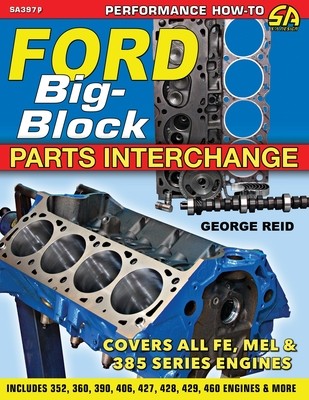
- Išsiųsime per 10–14 d.d.
- Autorius: Reid George
- Leidėjas: Cartech
- ISBN-10: 1613257376
- ISBN-13: 9781613257371
- Formatas: 21.6 x 27.9 x 0.8 cm, minkšti viršeliai
- Kalba: Anglų
- Extra -15 % nuolaida šiai knygai su kodu: ENG15
Atsiliepimai
Aprašymas
The photos in this edition are black and white.
Get a complete look at Ford Big-Block parts interchange and availability from author George Reid, a Ford expert and historian.
Engine components covered in Ford Big-Block Parts Interchange include cranks, rods, pistons, camshafts, engine blocks, intake and exhaust manifolds, carburetors, distributors, and more. Expanding from the previous edition of High-Performance Ford Parts Interchange that covered both small- and big-block engines in one volume, this book cuts out the small-block information and devotes every page to the MEL, FE and 385 series big-blocks from Ford, which allows for more complete and extensive coverage.
Over the course of performance car history, and specifically muscle car history, big-block engines are particularly beloved, and for good reason. Not only are they the essence of what a muscle car is, but before modern technology and stroker engines, they were also the best way to make a lot of horsepower. All of the Detroit manufacturers had their versions of big-block engines, and Ford was no exception. Actually, Ford was somewhat unique in that it had two very different big-block engine designs during the muscle car era.
The FE engine was a design pioneered in the late 1950s, primarily as a more powerful replacement for the dated Y-block design because cars were becoming bigger and heavier, and therefore, necessitated more power to move. What started as torquey engines meant to move heavyweight sedans morphed into screaming high-performance mills that won Le Mans and drag racing championships through the 1960s. By the late 1960s, the design was dated, so Ford replaced the FE design with the "385" series, also known as the "Lima" design, which was more similar to the canted-valve Cleveland design being pioneered at the same time. It didn't share the 1960s pedigree of racing success, but the new design was better in almost every way; it exists via Ford motorsports offerings to this day.
EXTRA 15 % nuolaida
Kupono kodas: ENG15
Akcija baigiasi už 5d.20:44:59
Nuolaidos kodas galioja perkant nuo 10 €. Nuolaidos nesumuojamos.

- Autorius: Reid George
- Leidėjas: Cartech
- ISBN-10: 1613257376
- ISBN-13: 9781613257371
- Formatas: 21.6 x 27.9 x 0.8 cm, minkšti viršeliai
- Kalba: Anglų
The photos in this edition are black and white.
Get a complete look at Ford Big-Block parts interchange and availability from author George Reid, a Ford expert and historian.
Engine components covered in Ford Big-Block Parts Interchange include cranks, rods, pistons, camshafts, engine blocks, intake and exhaust manifolds, carburetors, distributors, and more. Expanding from the previous edition of High-Performance Ford Parts Interchange that covered both small- and big-block engines in one volume, this book cuts out the small-block information and devotes every page to the MEL, FE and 385 series big-blocks from Ford, which allows for more complete and extensive coverage.
Over the course of performance car history, and specifically muscle car history, big-block engines are particularly beloved, and for good reason. Not only are they the essence of what a muscle car is, but before modern technology and stroker engines, they were also the best way to make a lot of horsepower. All of the Detroit manufacturers had their versions of big-block engines, and Ford was no exception. Actually, Ford was somewhat unique in that it had two very different big-block engine designs during the muscle car era.
The FE engine was a design pioneered in the late 1950s, primarily as a more powerful replacement for the dated Y-block design because cars were becoming bigger and heavier, and therefore, necessitated more power to move. What started as torquey engines meant to move heavyweight sedans morphed into screaming high-performance mills that won Le Mans and drag racing championships through the 1960s. By the late 1960s, the design was dated, so Ford replaced the FE design with the "385" series, also known as the "Lima" design, which was more similar to the canted-valve Cleveland design being pioneered at the same time. It didn't share the 1960s pedigree of racing success, but the new design was better in almost every way; it exists via Ford motorsports offerings to this day.




Atsiliepimai